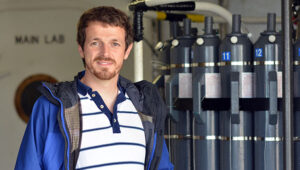Scientist at Work: A Conversation with BIOS Biologist Leocadio “Leo” Blanco-Bercial

Leo Blanco-Bercial grew up fishing for mackerel and tuna off the coast of his native Spain, but for his career has gravitated to studies of the tiniest of marine organisms: plankton. Blanco-Bercial, 36, began work at BIOS in January with the intention of continuing his plankton studies, specifically their genetics. He also plans to continue educating his Europe-based family, he said. “During visits home, I like explaining how plankton nourish the fish that we love catching and eating.”
What sparked your interest in an oceanography career?
I am originally from the seaside town Gijón, in Spain. My family’s house is about 100 meters from the shore. Our daily life is very sea-dependent and our free time is spent on marine-related activities; beginning when I was 9, I remember fishing for our dinners, learning how to pilot a boat, and using a compass. Growing up, it was typical to spend Saturday mornings at the beach with friends, or sail and hike in the intertidal zone with my two older sisters, grandparents, aunts, and uncles.
How did you become interested in the genetics and distribution of tiny marine creatures?
Originally I gravitated toward land-based ecology, but I ended up starting my doctoral work in marine zoology and ecology because of funds available in the department. The oceanographic group was heavily funded, with two large projects and a time series off the northwest coast of Spain called RADIALES. Actually, through RADIALES I learned about BIOS and the BATS program, and I remember thinking how it sounded amazing and that it would be cool to work there. During my doctoral work, I added a bit of genetics to solve an ecological question about I was working with a group of closely related species of plankton that live together. I tried to understand what resources each was exploiting, to see how they could share space without excluding each other. During that project I met my post-doc advisor, and with her, I moved more into population genetics and dispersal.
What lead you to your current research?
While doing research for my doctoral work I visited Ann Bucklin’s labs at the University of New Hampshire and the University of Connecticut. She learned about my sea-going experience and my knowledge of plankton taxonomy and molecular tools, and invited me on a couple of cruises within the Census of Marine Zooplankton. I’m a bit of a Jack-of-all-trades, which is helpful in this field. Ann liked my work, apparently, because she hired me as post-doc. Then my research got a heavier genetic component, both for population genetics and the evolution of species, a field called phylogeny. In the last couple years, we added a dispersal component to our focus, collaborating with modelers from WHOI. We also moved into questions related to organisms’ adaptations to environmental changes.
I understand it was your “Jack-of-all-trades” quality that landed you on a Woods Hole Oceanographic Institution (WHOI) research vessel in 2011, where you first met your wife, Amy Maas?
I think people like that I maintain a sense of humor, even after hours of work in the wet and cold, and without sleep. Apparently my reputation got around; my advisor’s husband, who is a researcher at WHOI, had a project with Amy’s post-doc advisor. They had a month-long cruise out of Woods Hole, and they were short on personnel with experience at sea, so they asked me to be part of the night watch. I personally like going to cruises, so I accepted. Lucky for me, Amy was on board.

How do you anticipate collaborating with Amy at BIOS?
Our plans include going back a bit in my research history, to ecology and population dynamics, but also carrying my genomic work and combining them with Amy’s environmental and organismal physiology. We are interested in the temporal component in the open ocean (seasonal and over years) and BIOS and BATS are a unique opportunity for this.
What have been your first priorities at BIOS?
At BIOS my first steps will be trying to add a molecular component to the zooplankton research with BATS. It will be fitting since I started my research years ago on a time series. Also, I have collaborators interested in the subterranean caves that surround Bermuda. These caves are in areas where fresh and saline water mix, so they are unique because they harbor some of the oldest lineages of crustaceans. We have some interesting questions to ask about their genetics, to solve relationships within those groups, but also related to the adaptations to such unusual and fragile environments in the view of the changing global environment.
